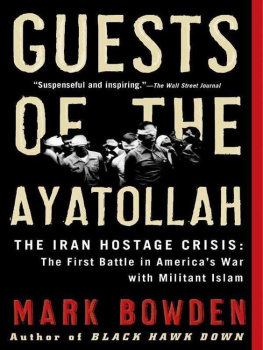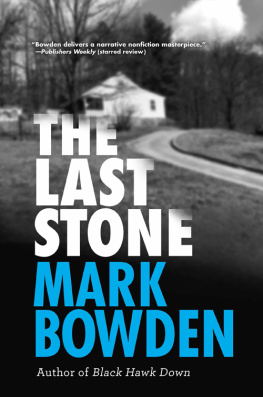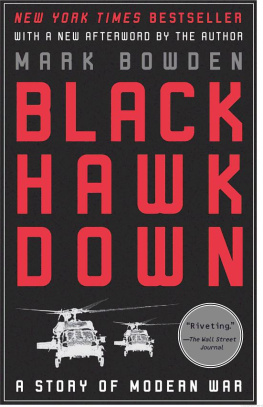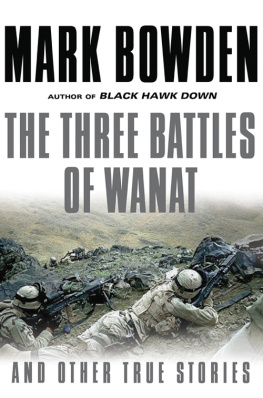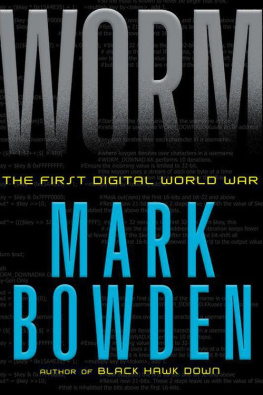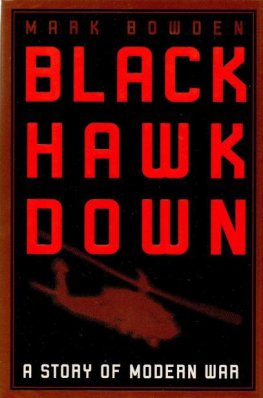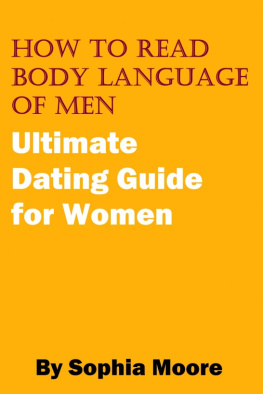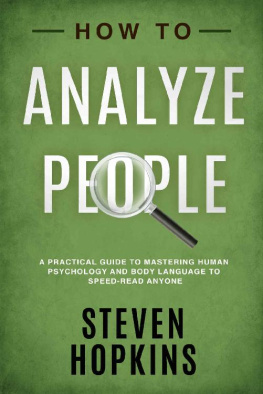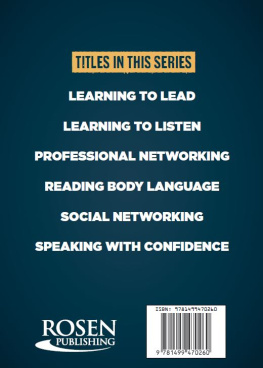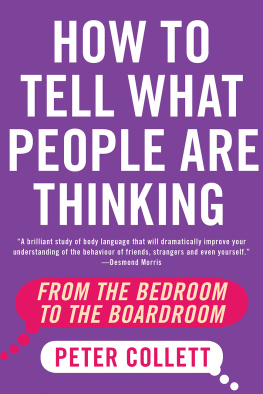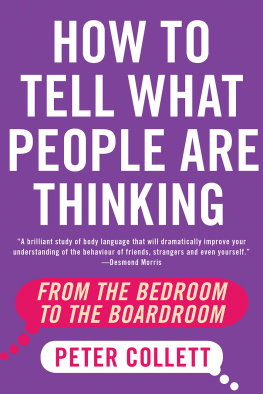Contents
Contents
Guide
Mark Bowden and Tracey Thomson give us a front row seat to understanding nonverbal communication and human behavior.
T ONYA R EIMAN , behavioral analyst and author of The Body Language of Dating
The cluttered space of body language clickbait continues to grow, but Truth & Lies clears a path to clarity and focus.
S COTT R OUSE , body language analyst and military interrogation trainer
A thoroughly insightful read, packed full of useful information to put to immediate and practical use. Let Mark and Tracey guide you to success and increase your awareness of other people.
C RAIG J AMES B AXTER , author of Behind the Mask
If youve ever wondered what selfies say, why people ghost, and how to detect the signals of deception in the physical and digital world, then Truth & Lies is the definitive, nonverbal communication book of this generation.
J AMIE M ASON C OHEN , handwriting analyst for criminal profilers and TEDx speaker
Fascinating, revealing and, at times, unsettling, Truth & Lies explains the nuances of body language to help you better understand the complexities of human behavior and discover what people are really thinking.
V ICTORIA S TILWELL , principal at Positively and author of Its Me or the Dog
Winning Body Language: Control the Conversation, Command Attention, and Convey the Right Message without Saying a Word
Winning Body Language for Sales Professionals: Control the Conversation and Connect with Your Customer without Saying a Word
Tame the Primitive Brain: 28 Ways in 28 Days to Manage the Most Impulsive Behaviors at Work
For Lex and Stella
Everything we see is a perspective, not the truth
Falsely attributed to Marcus Aurelius (author unknown)
WE CAN ALL RECALL EXAMPLES when our sense of what another person was thinking turned out to be the truth. Equally so, there have been times when we were so sure we were reading another person right only to discover, after the fact, how dead wrong we were. Sometimes, we learn the hard way that we were purposely lied to and cannot believe we did not see it for even one moment... until it was too late. Chances are that no matter the case, we were relying to some extent on correctly reading anothers body language.
We are inundated through news and social media with clickbait, articles and guides on how to read body language, which attempt to make it quick and easy for us to glance at someone and deduce their most secret thoughts. For example, theyve crossed their arms, so obviously they dont like what Im saying. Theyve pointed their feet elsewhereclearly, they are more attracted to someone else in the room. They scratched their nose, so theyre a no-good liar.
The problem is that while some of the time our quick read of someones body language may correctly uncover the truth about what they are thinking, all too often our readings and interpretations prove incorrect in the moment and we get it horribly wrong. On a good day there is only about a fifty-fifty chance of being correct.
Having said that, people who are truly practiced at the skill of reading and interpreting body language have found that by following tried and trusted processes, they can be far more effective at deducing what people are really thinking.
HERE IS A STORY from someone whose job it has been, in the interest of public safety, to always get the reading right: to examine behaviors, make an informed judgment from them, and then test how accurate his judgments are to uncover the truth of the matter. Read on and ask yourself how much you would trust your current body language reading skills in this situation, where stress and the stakes are high, in order to catch a murderer.
Our colleague and friend Paul Nadeau is a former police detective with twenty-five years of investigative background, including homicide, and was a trained polygraph examinerin other words, a professional lie detector. Paul describes the polygraph as an instrument that can detect the slightest physiological changes in someones body; changes that can occur when someone is anxious giving a deceitful answer to a clear question. As the polygraph examiner, Paul had to record and analyze the stress shown when answering questions to determine which ones the examinee may have lied about.
Paul notes that, of course, individuals who agree to take a polygraph examination may indeed already be in quite an anxious state, particularly if they are being investigated by the police. Someone in Pauls position understands that if a person being questioned is immediately attached to a polygraph, there is every chance of getting a false positive resultthey might look like a liar, even when they are not.
Before hooking any suspect up to the instrument, I would first take some time to bring the examinee to a calmer state, putting them at ease. But thats not all. I would also be watching every movement made by the examinee. Taking mental snapshots of that persons physicality; looking for changesespecially as we move onto talking casually about the subject matter under investigation.
Paul shared with us one real-life situation, a homicide case where a gang member had been found in a rival gangs territory stabbed to death, with three deep knife wounds to the heart. The theory was that the gang was sending a powerful message: Do not trespass on our turfor else! The suspects were any and all of the rival gangs members. Unsurprisingly, each gang member denied committing the murder, and each of them was requested by the police to take a polygraph test.
It was Pauls task to interview and give polygraph tests individually to the entire rival gang, any of whom could be the murderer, and all of whom denied any involvement. But then there was rival gang member number six, whom Paul describes as displaying body language that felt to him cocky and argumentative. His chin was up and pushed out defiantly. He looked down his nose at me with a lopsided snarl. He hated all cops and had no respect for them. Right off the bat, Paul, a veteran of interrogation and lie detection, put the suspect at ease by leaning in and confiding that he too felt much the same way about the officers he worked with. This tactic paid off in that the gang member warmed to him and they got to making small talk.
Once they were involved in more relaxed banter, the gang member chatting about his family and girlfriends, Paul noted that he was at this point openly displaying a true smile, with no seemingly defensive postures. Paul was effectively establishing an understanding for himself of this individuals most normal behavior in the interview situation when in a relaxed state.
The crucial moment of body language interpretation happened when Paul purposely and abruptly shifted the conversation to the topic of the homicide. His eyes left mine, his head turned away and his arms crossed. Although he answered no to being involved, his verbal answers were inconsistent with what his body language was now broadcasting to me... the more I asked about his involvement, the more he leaned back into his chairuncomfortably so.
This extreme change in body language was all Paul needed to see to have a strong suspicion that this guy was guilty.
To test his theory, Paul confronted him with a powerful question: You didnt intend to kill him. You just wanted to teach him a lessonDont come back! Otherwise, Im sure you would have stabbed him much more than three times. Isnt that the way it happened?
The gang member dropped his head into his hands and turned away from Paul, hiding his face. He confessed then and there to the murder and was later convicted in court.
For Paul, taking mental snapshots of the behavior as he went through this interrogation, creating moments when a change in body language would stand out, as well as evaluating whether the suspects words were consistent with the body language he saw, and taking the moment to test his conjecture, made him a human lie detectorhe had no need for the polygraph.


